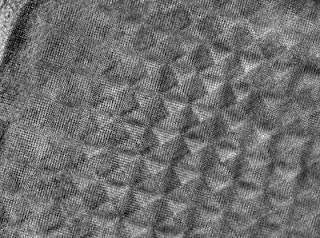University of Pennsylvania engineers discover natural 'workbench' for nanoscale construction
The findings appear in the August issue of Nature Materials.
Alerted by an unusual diffraction effect of a common ceramic material, researchers used imaging to identify a two-phase structural pattern ideal as the first step towards nanodevice construction. Practical application of nanotechnology will rely upon engineering’s ability to manipulate atoms and molecules into long-range order to produce materials with desired functionalities. The Penn findings provide a simpler method for the ordering of composite parts on the nanometer scale, which is integral to the incorporation of nano-objects such as particles and wires that make up nanodevices.
The material used in the Penn study is an ionically- conductive, crystalline ceramic (Nd2/3-xLi3x)TiO3 that engineers observed with transmission electron microscopy. The powdered perovskite exhibited two distinct patterns at the atomic scale with identical periodicity: a nanoscale chessboard pattern and a diamond pattern that indicated periodic separation into two phases within the structure. This spontaneous separation of phases could present a new foundation on which to build nanodevice technology. This material – made using standard and easily reproducible ceramic processing methods – represents the formation of a spontaneous microscopic surface controlled on the nanoscale with atomic precision.
Further study revealed that the separation of the structure into two distinct phases was a result of the oxide separating into lithium rich squares and lithium poor stripes. By varying the amount of lithium and neodymium, two ingredients in the ceramic powder, engineers controlled the length and spacing of the alternating phases, thereby tuning the workbench upon which nanodevices could be built.
On a larger-than-atomic scale, the research extends science’s knowledge of the properties of a most common oxide structure type, currently used for superconducting materials, magnetoresistive materials and ferroelectrics.
“This study represents great potential for the use of standard ceramic processing methods for nanotechnology,” said Peter K. Davies, chair of the Department of Materials Science and Engineering at Penn. “The phase separation occurs spontaneously, providing two phases whose dimensions both extend into the nanometer scale. This unique feature could lead to its application as a template for the assembly of nanostructures or molecular monolayers.” ###
The research was performed by Davies and Beth S. Guiton of the Department of Materials Science and Engineering in Penn’s School of Engineering and Applied Science.
The research was supported by the National Science Foundation.
Contact: Jordan Reese jreese@pobox.upenn.edu 215-573-6604 University of Pennsylvania
Technorati Tags: Nano or Nanotechnology and Nanotech and nanostructures or atomically tuneable nanocomposite and University of Pennsylvania or Superlattice periodicity or Beyond A.I. -- Creating the Conscience of the Machine and Political Party Symbols Republican Elephant and Pakistan's Future: Building Democracy, or Fueling Extremism? VIDEO PODCAST















No comments:
Post a Comment